weight BMW ACTIVE HYBRID 3 2014 F30H Owner's Manual
[x] Cancel search | Manufacturer: BMW, Model Year: 2014, Model line: ACTIVE HYBRID 3, Model: BMW ACTIVE HYBRID 3 2014 F30HPages: 247, PDF Size: 6.04 MB
Page 57 of 247
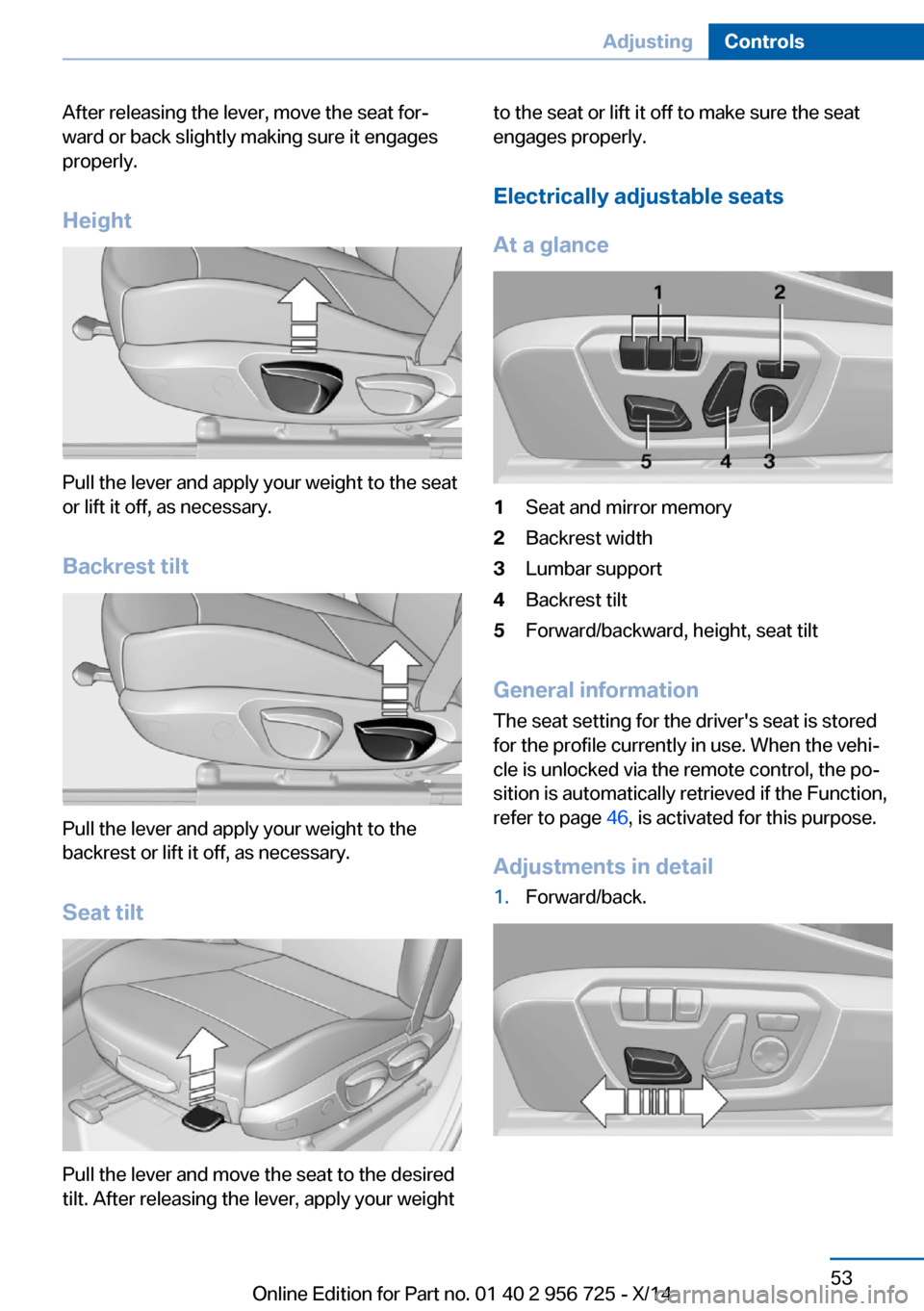
After releasing the lever, move the seat for‐
ward or back slightly making sure it engages
properly.
Height
Pull the lever and apply your weight to the seat
or lift it off, as necessary.
Backrest tilt
Pull the lever and apply your weight to the
backrest or lift it off, as necessary.
Seat tilt
Pull the lever and move the seat to the desired
tilt. After releasing the lever, apply your weight
to the seat or lift it off to make sure the seat
engages properly.
Electrically adjustable seats
At a glance1Seat and mirror memory2Backrest width3Lumbar support4Backrest tilt5Forward/backward, height, seat tilt
General information
The seat setting for the driver's seat is stored
for the profile currently in use. When the vehi‐
cle is unlocked via the remote control, the po‐
sition is automatically retrieved if the Function,
refer to page 46, is activated for this purpose.
Adjustments in detail
1.Forward/back.Seite 53AdjustingControls53
Online Edition for Part no. 01 40 2 956 725 - X/14
Page 66 of 247
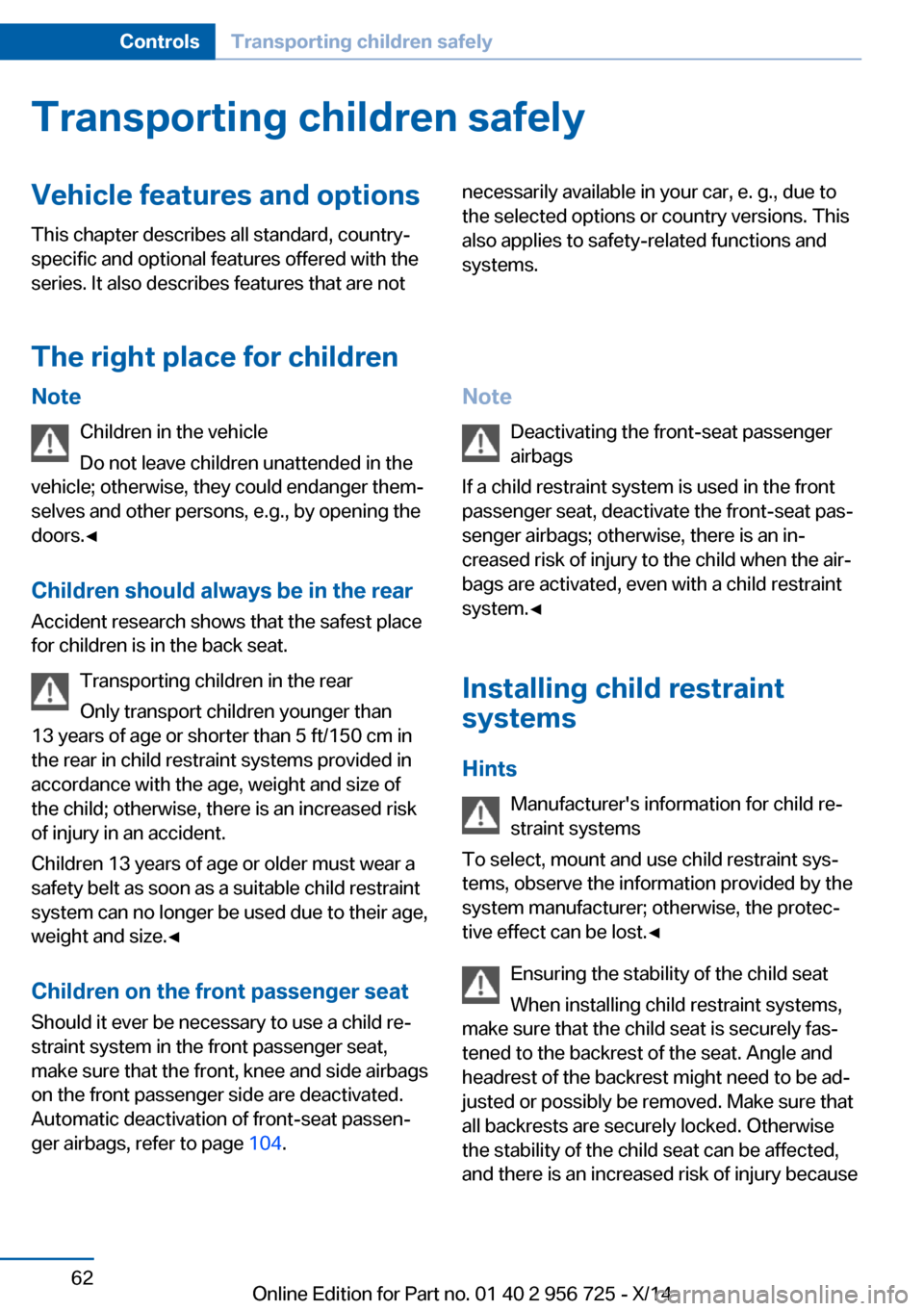
Transporting children safelyVehicle features and optionsThis chapter describes all standard, country-
specific and optional features offered with the
series. It also describes features that are notnecessarily available in your car, e. g., due to
the selected options or country versions. This
also applies to safety-related functions and
systems.
The right place for children
Note
Children in the vehicle
Do not leave children unattended in the
vehicle; otherwise, they could endanger them‐
selves and other persons, e.g., by opening the
doors.◀
Children should always be in the rear Accident research shows that the safest place
for children is in the back seat.
Transporting children in the rear
Only transport children younger than
13 years of age or shorter than 5 ft/150 cm in
the rear in child restraint systems provided in
accordance with the age, weight and size of
the child; otherwise, there is an increased risk
of injury in an accident.
Children 13 years of age or older must wear a
safety belt as soon as a suitable child restraint
system can no longer be used due to their age,
weight and size.◀
Children on the front passenger seat
Should it ever be necessary to use a child re‐
straint system in the front passenger seat,
make sure that the front, knee and side airbags
on the front passenger side are deactivated.
Automatic deactivation of front-seat passen‐
ger airbags, refer to page 104.Note
Deactivating the front-seat passenger
airbags
If a child restraint system is used in the front
passenger seat, deactivate the front-seat pas‐
senger airbags; otherwise, there is an in‐
creased risk of injury to the child when the air‐
bags are activated, even with a child restraint
system.◀
Installing child restraint
systems
Hints Manufacturer's information for child re‐straint systems
To select, mount and use child restraint sys‐
tems, observe the information provided by the
system manufacturer; otherwise, the protec‐
tive effect can be lost.◀
Ensuring the stability of the child seat
When installing child restraint systems,
make sure that the child seat is securely fas‐
tened to the backrest of the seat. Angle and
headrest of the backrest might need to be ad‐
justed or possibly be removed. Make sure that
all backrests are securely locked. Otherwise
the stability of the child seat can be affected,
and there is an increased risk of injury becauseSeite 62ControlsTransporting children safely62
Online Edition for Part no. 01 40 2 956 725 - X/14
Page 68 of 247
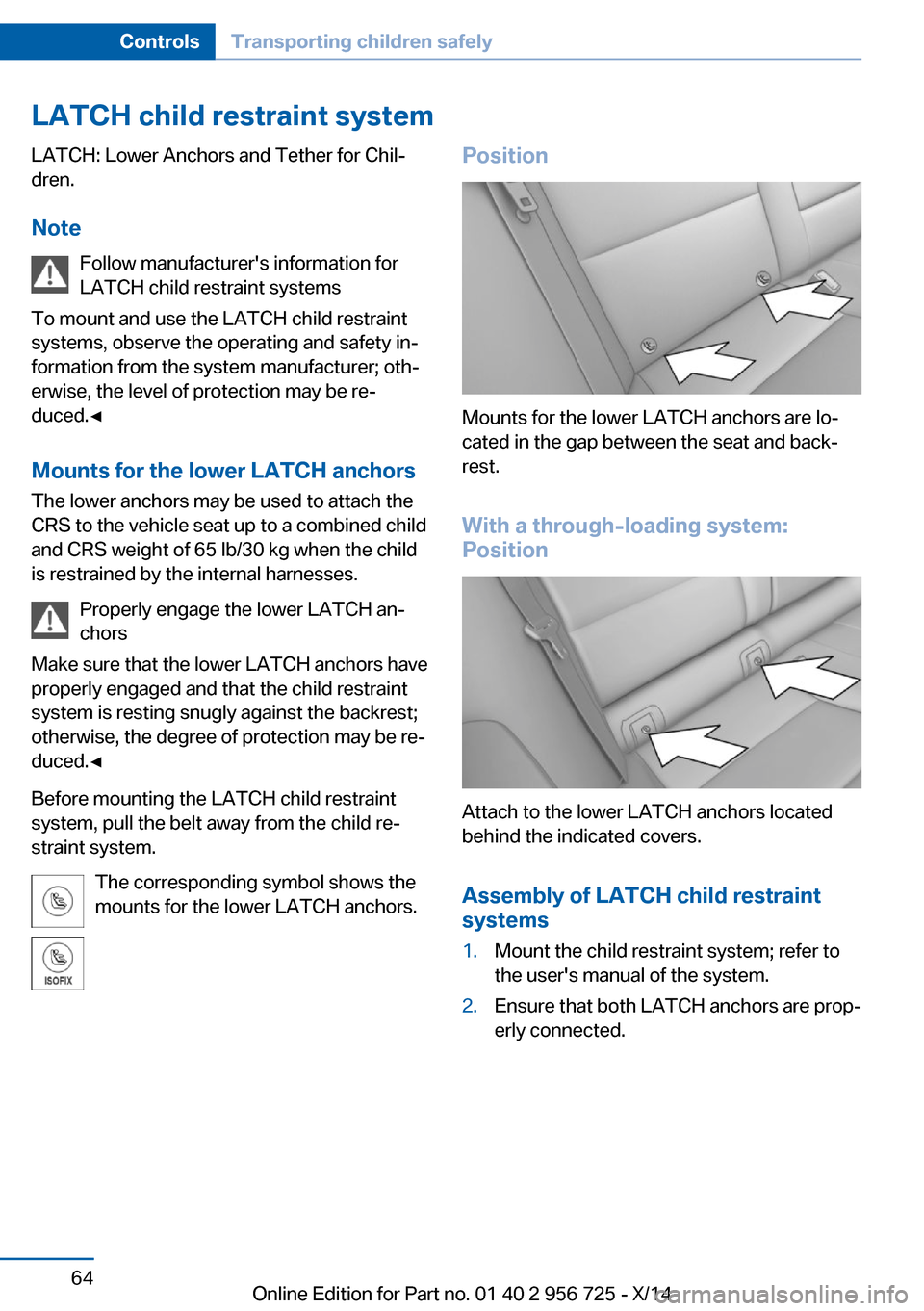
LATCH child restraint systemLATCH: Lower Anchors and Tether for Chil‐
dren.
Note Follow manufacturer's information for
LATCH child restraint systems
To mount and use the LATCH child restraint
systems, observe the operating and safety in‐
formation from the system manufacturer; oth‐
erwise, the level of protection may be re‐
duced.◀
Mounts for the lower LATCH anchors
The lower anchors may be used to attach the
CRS to the vehicle seat up to a combined child
and CRS weight of 65 lb/30 kg when the child
is restrained by the internal harnesses.
Properly engage the lower LATCH an‐
chors
Make sure that the lower LATCH anchors have
properly engaged and that the child restraint
system is resting snugly against the backrest; otherwise, the degree of protection may be re‐
duced.◀
Before mounting the LATCH child restraint
system, pull the belt away from the child re‐
straint system.
The corresponding symbol shows the
mounts for the lower LATCH anchors.Position
Mounts for the lower LATCH anchors are lo‐
cated in the gap between the seat and back‐
rest.
With a through-loading system:
Position
Attach to the lower LATCH anchors located
behind the indicated covers.
Assembly of LATCH child restraint
systems
1.Mount the child restraint system; refer to
the user's manual of the system.2.Ensure that both LATCH anchors are prop‐
erly connected.Seite 64ControlsTransporting children safely64
Online Edition for Part no. 01 40 2 956 725 - X/14
Page 179 of 247
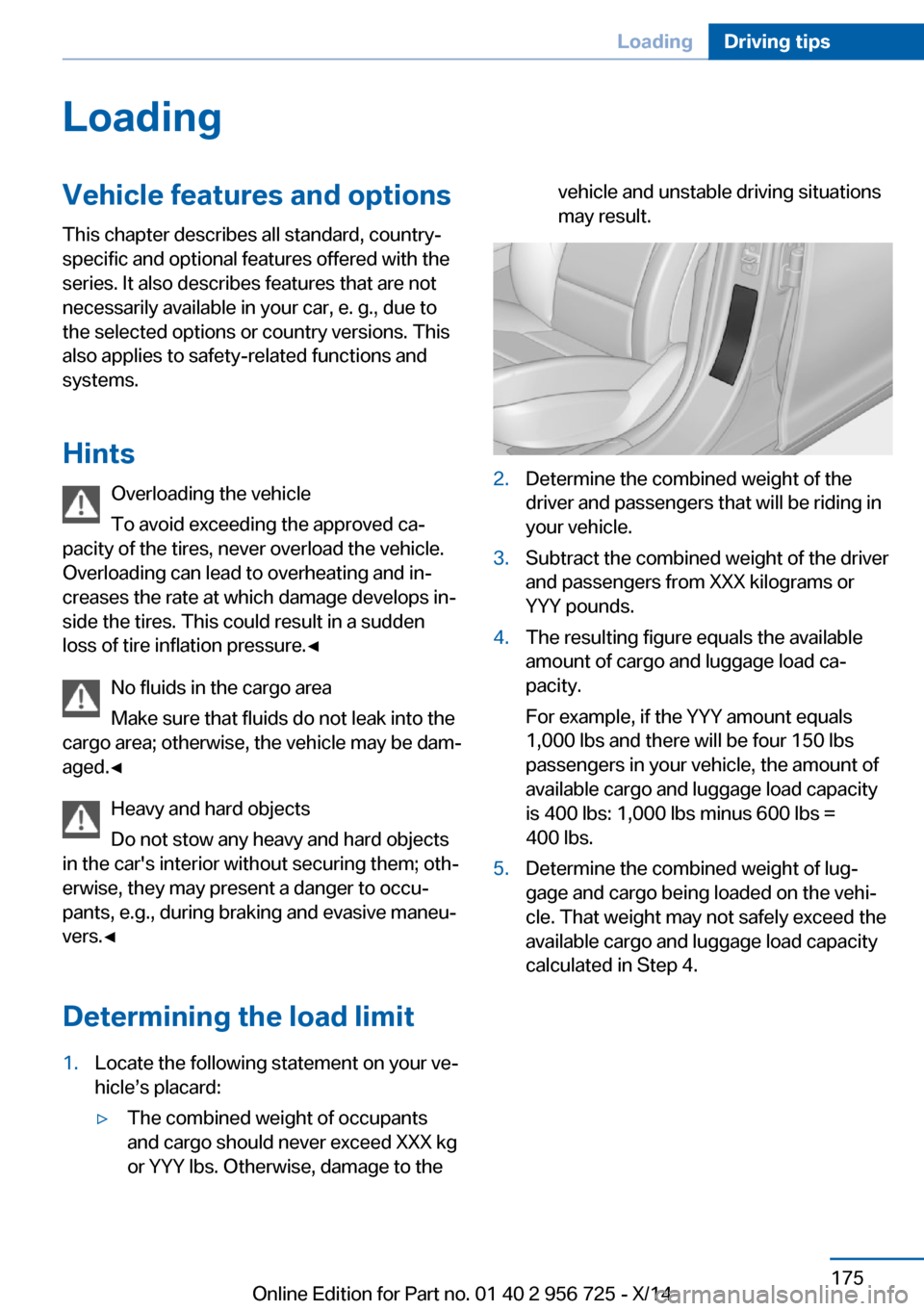
LoadingVehicle features and options
This chapter describes all standard, country-
specific and optional features offered with the
series. It also describes features that are not
necessarily available in your car, e. g., due to
the selected options or country versions. This
also applies to safety-related functions and
systems.
Hints Overloading the vehicle
To avoid exceeding the approved ca‐
pacity of the tires, never overload the vehicle.
Overloading can lead to overheating and in‐
creases the rate at which damage develops in‐
side the tires. This could result in a sudden
loss of tire inflation pressure.◀
No fluids in the cargo area
Make sure that fluids do not leak into the
cargo area; otherwise, the vehicle may be dam‐
aged.◀
Heavy and hard objects
Do not stow any heavy and hard objects
in the car's interior without securing them; oth‐
erwise, they may present a danger to occu‐
pants, e.g., during braking and evasive maneu‐
vers.◀
Determining the load limit1.Locate the following statement on your ve‐
hicle’s placard:▷The combined weight of occupants
and cargo should never exceed XXX kg
or YYY lbs. Otherwise, damage to thevehicle and unstable driving situations
may result.2.Determine the combined weight of the
driver and passengers that will be riding in
your vehicle.3.Subtract the combined weight of the driver
and passengers from XXX kilograms or
YYY pounds.4.The resulting figure equals the available
amount of cargo and luggage load ca‐
pacity.
For example, if the YYY amount equals
1,000 lbs and there will be four 150 lbs
passengers in your vehicle, the amount of
available cargo and luggage load capacity
is 400 lbs: 1,000 lbs minus 600 lbs =
400 lbs.5.Determine the combined weight of lug‐
gage and cargo being loaded on the vehi‐
cle. That weight may not safely exceed the
available cargo and luggage load capacity
calculated in Step 4.Seite 175LoadingDriving tips175
Online Edition for Part no. 01 40 2 956 725 - X/14
Page 180 of 247
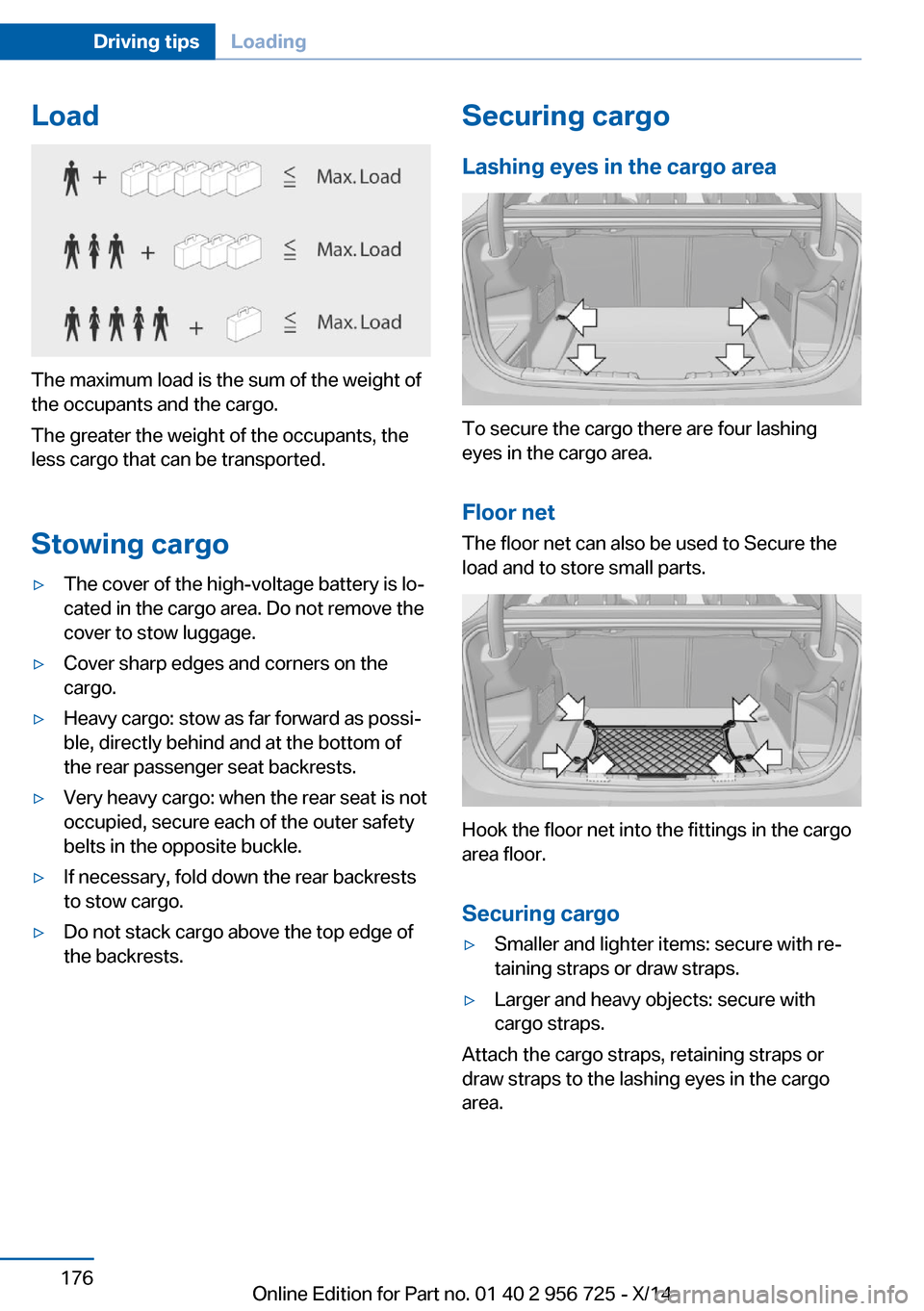
Load
The maximum load is the sum of the weight of
the occupants and the cargo.
The greater the weight of the occupants, the
less cargo that can be transported.
Stowing cargo
▷The cover of the high-voltage battery is lo‐
cated in the cargo area. Do not remove the
cover to stow luggage.▷Cover sharp edges and corners on the
cargo.▷Heavy cargo: stow as far forward as possi‐
ble, directly behind and at the bottom of
the rear passenger seat backrests.▷Very heavy cargo: when the rear seat is not
occupied, secure each of the outer safety
belts in the opposite buckle.▷If necessary, fold down the rear backrests
to stow cargo.▷Do not stack cargo above the top edge of
the backrests.Securing cargo
Lashing eyes in the cargo area
To secure the cargo there are four lashing
eyes in the cargo area.
Floor net
The floor net can also be used to Secure the
load and to store small parts.
Hook the floor net into the fittings in the cargo
area floor.
Securing cargo
▷Smaller and lighter items: secure with re‐
taining straps or draw straps.▷Larger and heavy objects: secure with
cargo straps.
Attach the cargo straps, retaining straps or
draw straps to the lashing eyes in the cargo
area.
Seite 176Driving tipsLoading176
Online Edition for Part no. 01 40 2 956 725 - X/14
Page 181 of 247
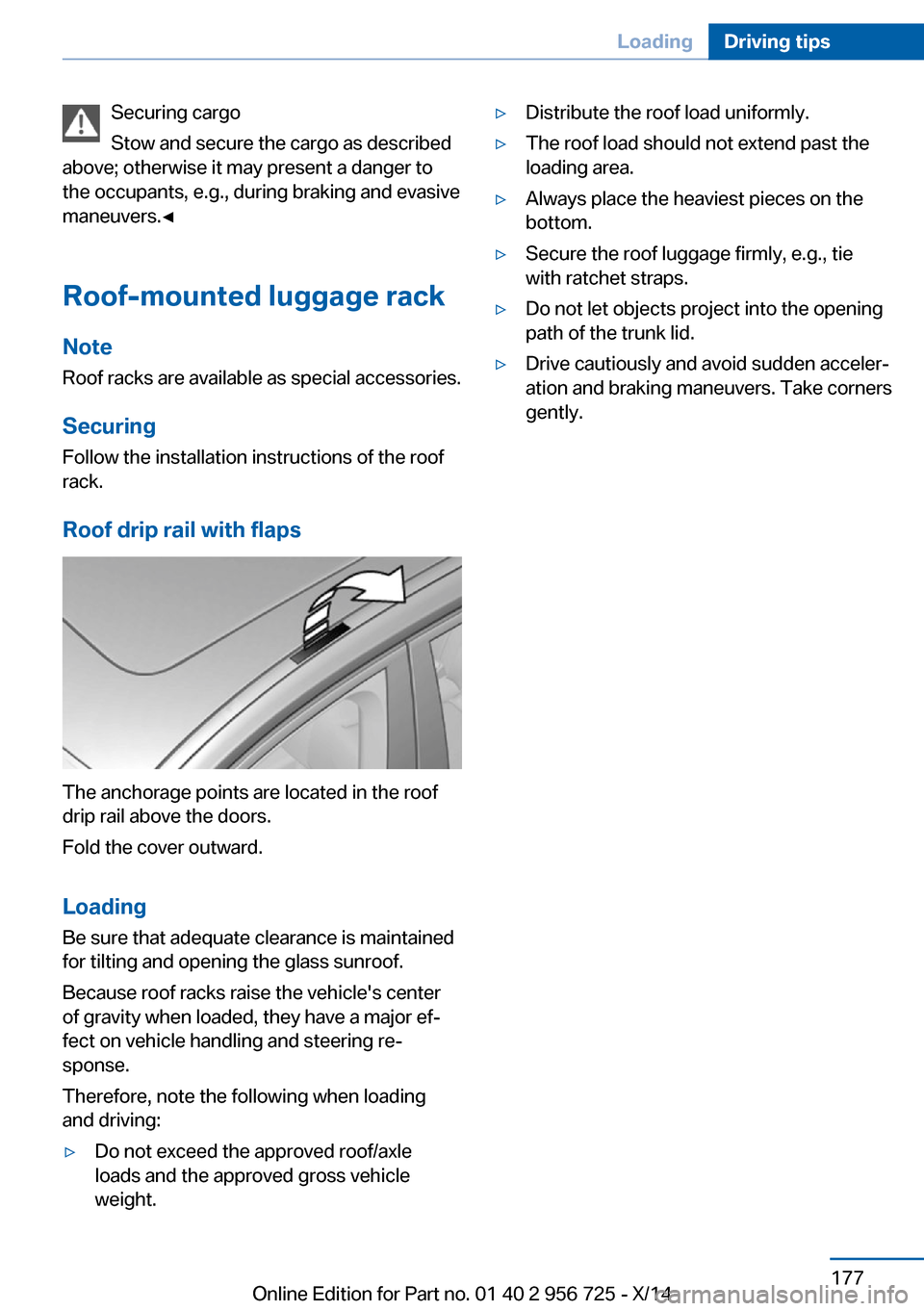
Securing cargo
Stow and secure the cargo as described
above; otherwise it may present a danger to
the occupants, e.g., during braking and evasive
maneuvers.◀
Roof-mounted luggage rack Note
Roof racks are available as special accessories.
Securing
Follow the installation instructions of the roof
rack.
Roof drip rail with flaps
The anchorage points are located in the roof
drip rail above the doors.
Fold the cover outward.
Loading Be sure that adequate clearance is maintained
for tilting and opening the glass sunroof.
Because roof racks raise the vehicle's center
of gravity when loaded, they have a major ef‐
fect on vehicle handling and steering re‐
sponse.
Therefore, note the following when loading
and driving:
▷Do not exceed the approved roof/axle
loads and the approved gross vehicle
weight.▷Distribute the roof load uniformly.▷The roof load should not extend past the
loading area.▷Always place the heaviest pieces on the
bottom.▷Secure the roof luggage firmly, e.g., tie
with ratchet straps.▷Do not let objects project into the opening
path of the trunk lid.▷Drive cautiously and avoid sudden acceler‐
ation and braking maneuvers. Take corners
gently.Seite 177LoadingDriving tips177
Online Edition for Part no. 01 40 2 956 725 - X/14
Page 182 of 247

Saving fuelVehicle features and optionsThis chapter describes all standard, country-
specific and optional features offered with the
series. It also describes features that are not
necessarily available in your car, e. g., due to
the selected options or country versions. This
also applies to safety-related functions and
systems.
General information
Your vehicle contains advanced technology for
the reduction of fuel consumption and emis‐
sions.
Fuel consumption depends on a number of dif‐
ferent factors.
Carrying out certain measures, such as a mod‐
erate driving style and regular maintenance,
can influence fuel consumption and the envi‐
ronmental impact.
Remove unnecessary cargoAdditional weight increases fuel consumption.
Remove attached parts
following use
Remove auxiliary mirrors, roof or rear luggage
racks which are no longer required following
use.
Attached parts on the vehicle impair the aero‐
dynamics and increase the fuel consumption.Close the windows and glass
sunroof
Driving with the glass sunroof and windows
open results in increased air resistance and
thereby reduces the range.
Tires
General information Tires can affect fuel consumption in various
ways, e.g., tire size may influence fuel con‐
sumption.
Check the tire inflation pressure
regularly
Check and, if needed, correct the tire inflation
pressure at least twice a month and before
starting on a long trip.
Low tire inflation pressure increases rolling re‐
sistance and thus raises fuel consumption and
tire wear.
Drive away immediately
Do not wait for the engine to warm-up while
the vehicle remains stationary. Start driving
right away, but at moderate engine speeds.
This is the quickest way of warming the cold
engine up to operating temperature.
Look well ahead when
driving
Avoid unnecessary acceleration and braking.
By maintaining a suitable distance to the vehi‐
cle driving ahead of you.
Driving smoothly and proactively reduces fuel
consumption.Seite 178Driving tipsSaving fuel178
Online Edition for Part no. 01 40 2 956 725 - X/14
Page 235 of 247

Weights
ActiveHybrid 3Approved gross vehicle weightlbs/kg4,815/2,184Loadlbs/kg900/408Approved front axle loadlbs/kg2,250/1,021Approved rear axle loadlbs/kg2,710/1,229Approved roof load capacitylbs/kg165.4/75Cargo area capacitycu ft/l13.8/390
Capacities
US gal/litersNotesFuel tank, approx.15/57Fuel quality, refer to
page 188Seite 231Technical dataReference231
Online Edition for Part no. 01 40 2 956 725 - X/14
Page 236 of 247

Everything from A to Z
IndexA ABS, Antilock Brake Sys‐ tem 124
ACC, Active Cruise Control with Stop & Go 129
Acceleration Assistant, refer to Launch Control 78
Activated-charcoal filter 153
Activate drive readiness 68
Active Blind Spot Detec‐ tion 120
Active Cruise Control with Stop & Go, ACC 129
ActiveHybrid, system 31
Adapting to the course of the road, hybrid system 83
Adaptive brake lights, refer to Brake force display 122
Adaptive Light Control 98
Additives, oil 201
Adjustments, seats/head re‐ straints 52
After washing vehicle 224
Airbags 102
Airbags, indicator/warning light 103
Air circulation, refer to Recir‐ culated-air mode 152
Air, dehumidifying, refer to Cooling function 151
Air distribution, manual 152
Air flow, automatic climate control 152
Air pressure, tires 190
Air vents, refer to Ventila‐ tion 153
Alarm system 46
Alarm, unintentional 47
All around the center con‐ sole 16 All around the roofliner 17
All around the steering wheel 14
All-season tires, refer to Win‐ ter tires 196
Alternating-code hand-held transmitter 157
Alternative oil types 202
Antifreeze, washer fluid 75
Antilock Brake System, ABS 124
Anti-slip control, refer to DSC 124
Approved axle load 231
Approved engine oils 202
Arrival time 92
Ash tray 160
Assistance for the combus‐ tion engine, ASSIST 71
Assistance for the combus‐ tion engine, eBOOST 71
Assistance, Roadside Assis‐ tance 218
Assistance when driving off 128
ASSIST, assistance for the combustion engine 71
Assist system information, on Control Display 95
Attentiveness assistant 122
AUTO intensity 151
Automatic car wash 223
Automatic climate control with enhanced features 150
Automatic Cruise Control with Stop & Go 129
Automatic Curb Monitor 60
Automatic deactivation, front- seat passenger airbags 104
Automatic deactivation of the hybrid system 222 Automatic engine start-stop
function 69
Automatic headlight con‐ trol 98
Automatic locking 45
Automatic recirculated-air control 152
Automatic transmission, see Steptronic transmission 76
AUTO program, automatic cli‐ mate control 151
AUTO program, intensity 151
Auxiliary air conditioning 154
Average fuel consumption 92
Average speed 92
Axle loads, weights 231
B Backrest curvature, refer to Lumbar support 54
Backrest, width 54
Band-aids, refer to First aid kit 218
Bar for tow-starting/ towing 220
Battery replacement, vehicle battery 215
Battery replacement, vehicle remote control 37
Battery, vehicle 215
Belts, safety belts 55
Beverage holder, cu‐ pholder 166
Blinds, sun protection 49
BMW ActiveHybrid 31
BMW Assist, see user's manual for Navigation, En‐
tertainment and Communi‐
cation Seite 232ReferenceEverything from A to Z232
Online Edition for Part no. 01 40 2 956 725 - X/14
Page 239 of 247
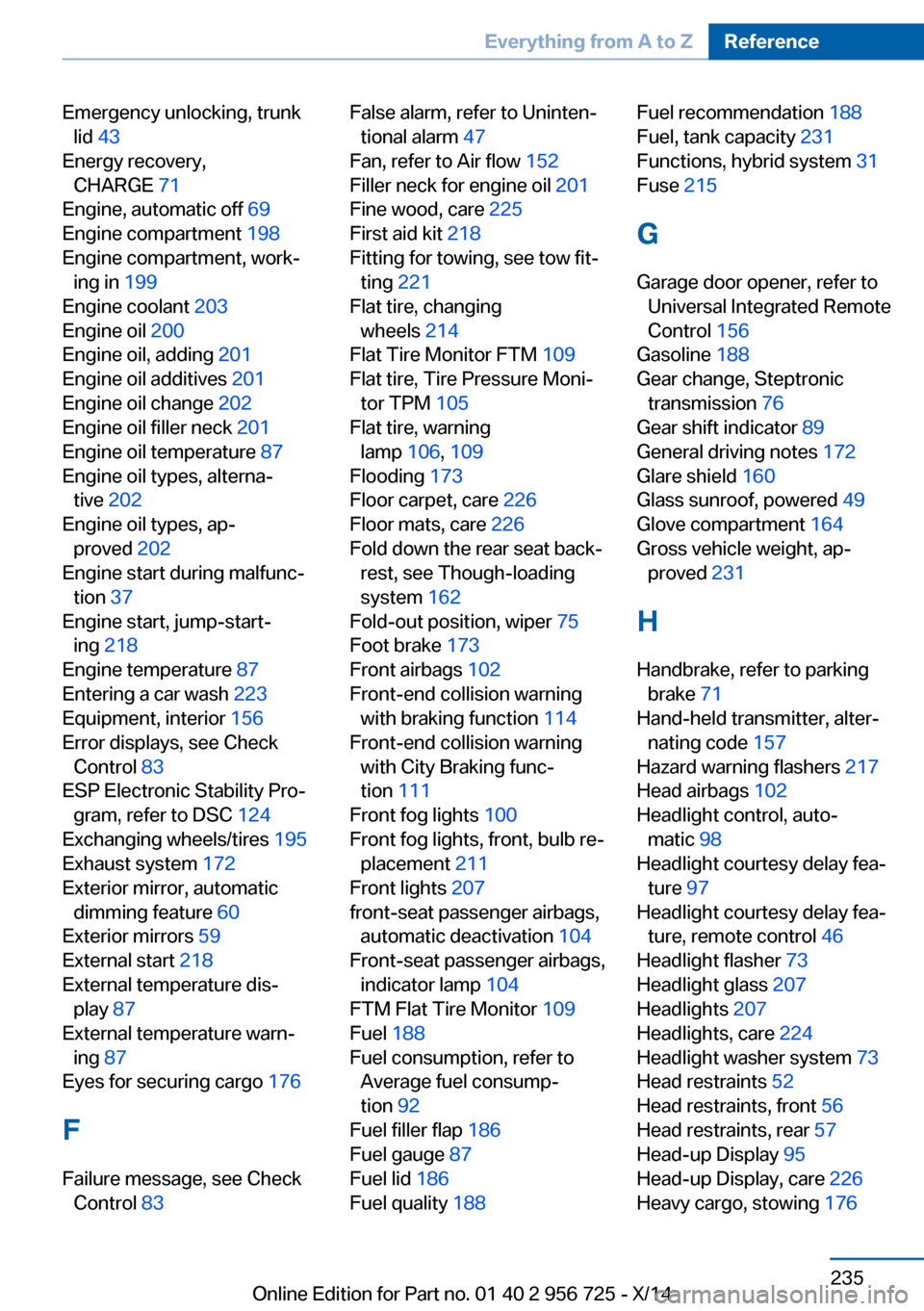
Emergency unlocking, trunklid 43
Energy recovery, CHARGE 71
Engine, automatic off 69
Engine compartment 198
Engine compartment, work‐ ing in 199
Engine coolant 203
Engine oil 200
Engine oil, adding 201
Engine oil additives 201
Engine oil change 202
Engine oil filler neck 201
Engine oil temperature 87
Engine oil types, alterna‐ tive 202
Engine oil types, ap‐ proved 202
Engine start during malfunc‐ tion 37
Engine start, jump-start‐ ing 218
Engine temperature 87
Entering a car wash 223
Equipment, interior 156
Error displays, see Check Control 83
ESP Electronic Stability Pro‐ gram, refer to DSC 124
Exchanging wheels/tires 195
Exhaust system 172
Exterior mirror, automatic dimming feature 60
Exterior mirrors 59
External start 218
External temperature dis‐ play 87
External temperature warn‐ ing 87
Eyes for securing cargo 176
F
Failure message, see Check Control 83 False alarm, refer to Uninten‐
tional alarm 47
Fan, refer to Air flow 152
Filler neck for engine oil 201
Fine wood, care 225
First aid kit 218
Fitting for towing, see tow fit‐ ting 221
Flat tire, changing wheels 214
Flat Tire Monitor FTM 109
Flat tire, Tire Pressure Moni‐ tor TPM 105
Flat tire, warning lamp 106, 109
Flooding 173
Floor carpet, care 226
Floor mats, care 226
Fold down the rear seat back‐ rest, see Though-loading
system 162
Fold-out position, wiper 75
Foot brake 173
Front airbags 102
Front-end collision warning with braking function 114
Front-end collision warning with City Braking func‐
tion 111
Front fog lights 100
Front fog lights, front, bulb re‐ placement 211
Front lights 207
front-seat passenger airbags, automatic deactivation 104
Front-seat passenger airbags, indicator lamp 104
FTM Flat Tire Monitor 109
Fuel 188
Fuel consumption, refer to Average fuel consump‐
tion 92
Fuel filler flap 186
Fuel gauge 87
Fuel lid 186
Fuel quality 188 Fuel recommendation 188
Fuel, tank capacity 231
Functions, hybrid system 31
Fuse 215
G
Garage door opener, refer to Universal Integrated Remote
Control 156
Gasoline 188
Gear change, Steptronic transmission 76
Gear shift indicator 89
General driving notes 172
Glare shield 160
Glass sunroof, powered 49
Glove compartment 164
Gross vehicle weight, ap‐ proved 231
H
Handbrake, refer to parking brake 71
Hand-held transmitter, alter‐ nating code 157
Hazard warning flashers 217
Head airbags 102
Headlight control, auto‐ matic 98
Headlight courtesy delay fea‐ ture 97
Headlight courtesy delay fea‐ ture, remote control 46
Headlight flasher 73
Headlight glass 207
Headlights 207
Headlights, care 224
Headlight washer system 73
Head restraints 52
Head restraints, front 56
Head restraints, rear 57
Head-up Display 95
Head-up Display, care 226
Heavy cargo, stowing 176 Seite 235Everything from A to ZReference235
Online Edition for Part no. 01 40 2 956 725 - X/14